Analysis of Communication at Mr. Fishy Restaurant: Report
VerifiedAdded on 2021/02/21
|7
|2115
|371
Report
AI Summary
This report provides an in-depth analysis of communication practices within Mr. Fishy, a fish and chips restaurant located in Borough Market. It begins with an introduction to the importance of communication in business operations, followed by an examination of the communication practices employed by staff and senior managers. The report identifies key barriers and challenges to effective communication, such as cultural differences, language barriers, and technological limitations, and proposes various strategies to overcome these obstacles. It also explores relevant theories of organizational communication, including Weber's classic theory, Tompkins and Cheney's organizational control theory, critical theory, and post-positive theory, and their application within the context of Mr. Fishy. Furthermore, the report details the purpose and principles behind different forms of organizational communication, emphasizing the importance of clarity, adequacy, consistency, and feedback. It then discusses the application of these principles to enhance business practices, followed by an evaluation of the current communication practices at Mr. Fishy and other organizations. The report concludes with a summary of key findings and recommendations for improving communication effectiveness.
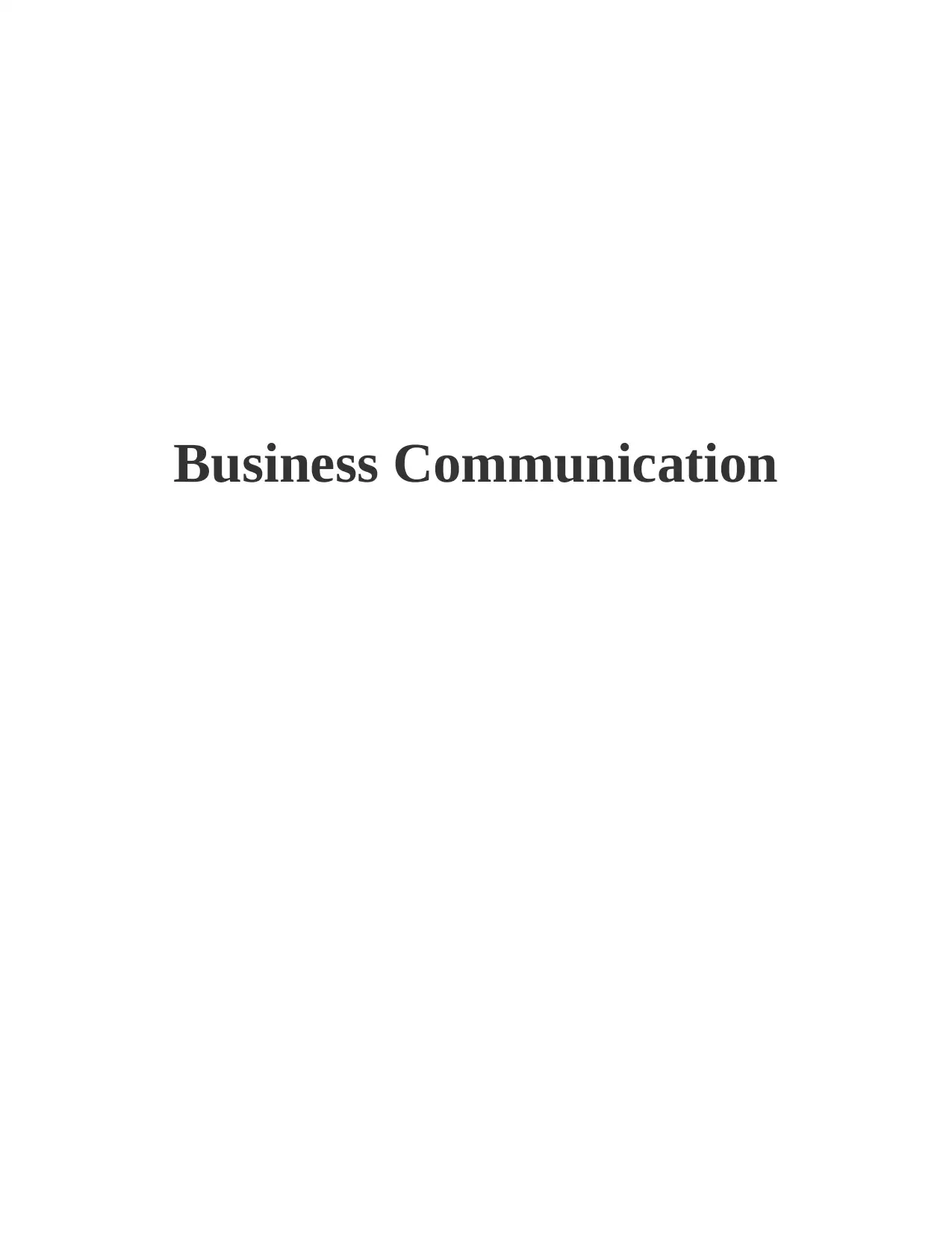
Business Communication
Paraphrase This Document
Need a fresh take? Get an instant paraphrase of this document with our AI Paraphraser
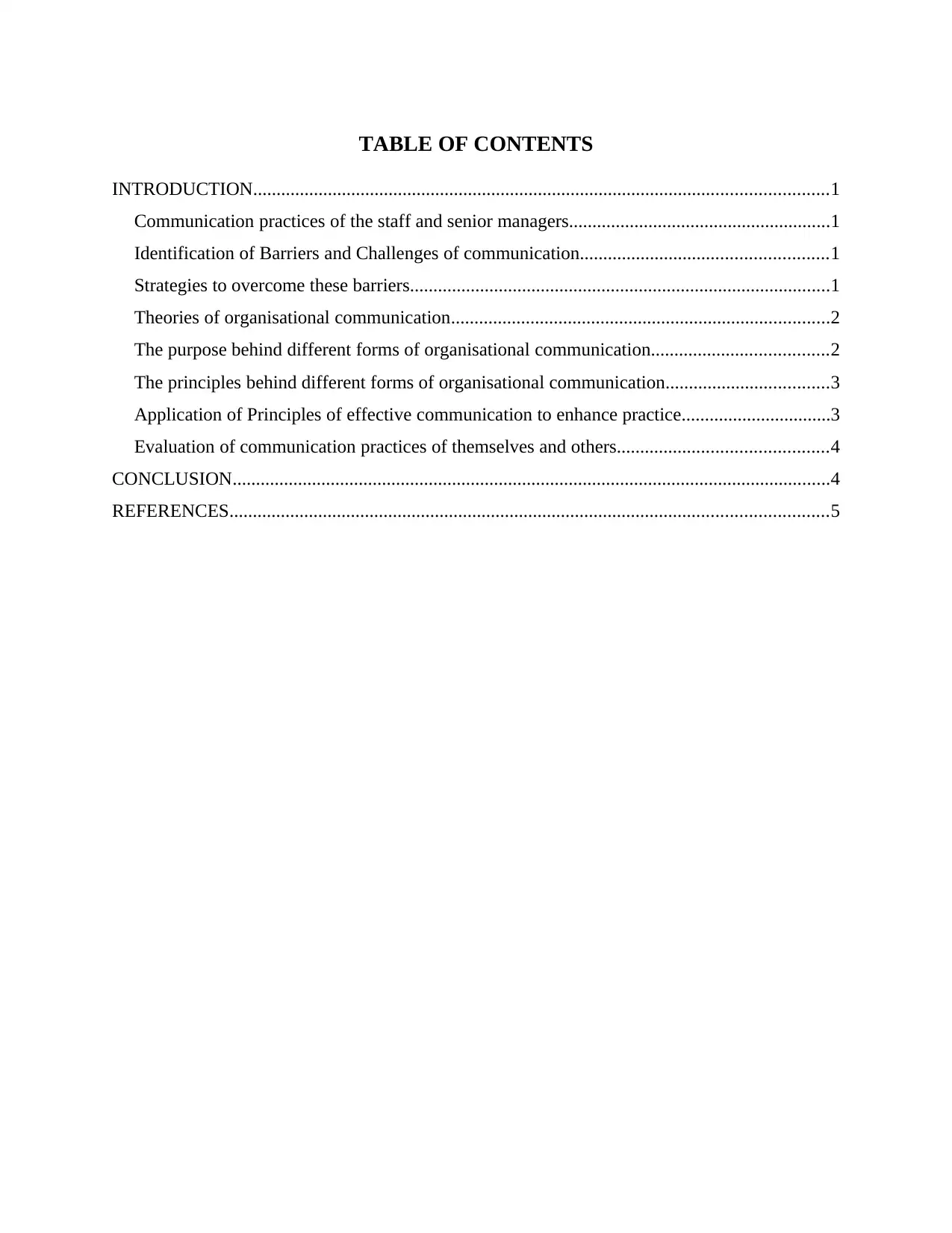
TABLE OF CONTENTS
INTRODUCTION...........................................................................................................................1
Communication practices of the staff and senior managers........................................................1
Identification of Barriers and Challenges of communication.....................................................1
Strategies to overcome these barriers..........................................................................................1
Theories of organisational communication.................................................................................2
The purpose behind different forms of organisational communication......................................2
The principles behind different forms of organisational communication...................................3
Application of Principles of effective communication to enhance practice................................3
Evaluation of communication practices of themselves and others.............................................4
CONCLUSION................................................................................................................................4
REFERENCES................................................................................................................................5
INTRODUCTION...........................................................................................................................1
Communication practices of the staff and senior managers........................................................1
Identification of Barriers and Challenges of communication.....................................................1
Strategies to overcome these barriers..........................................................................................1
Theories of organisational communication.................................................................................2
The purpose behind different forms of organisational communication......................................2
The principles behind different forms of organisational communication...................................3
Application of Principles of effective communication to enhance practice................................3
Evaluation of communication practices of themselves and others.............................................4
CONCLUSION................................................................................................................................4
REFERENCES................................................................................................................................5
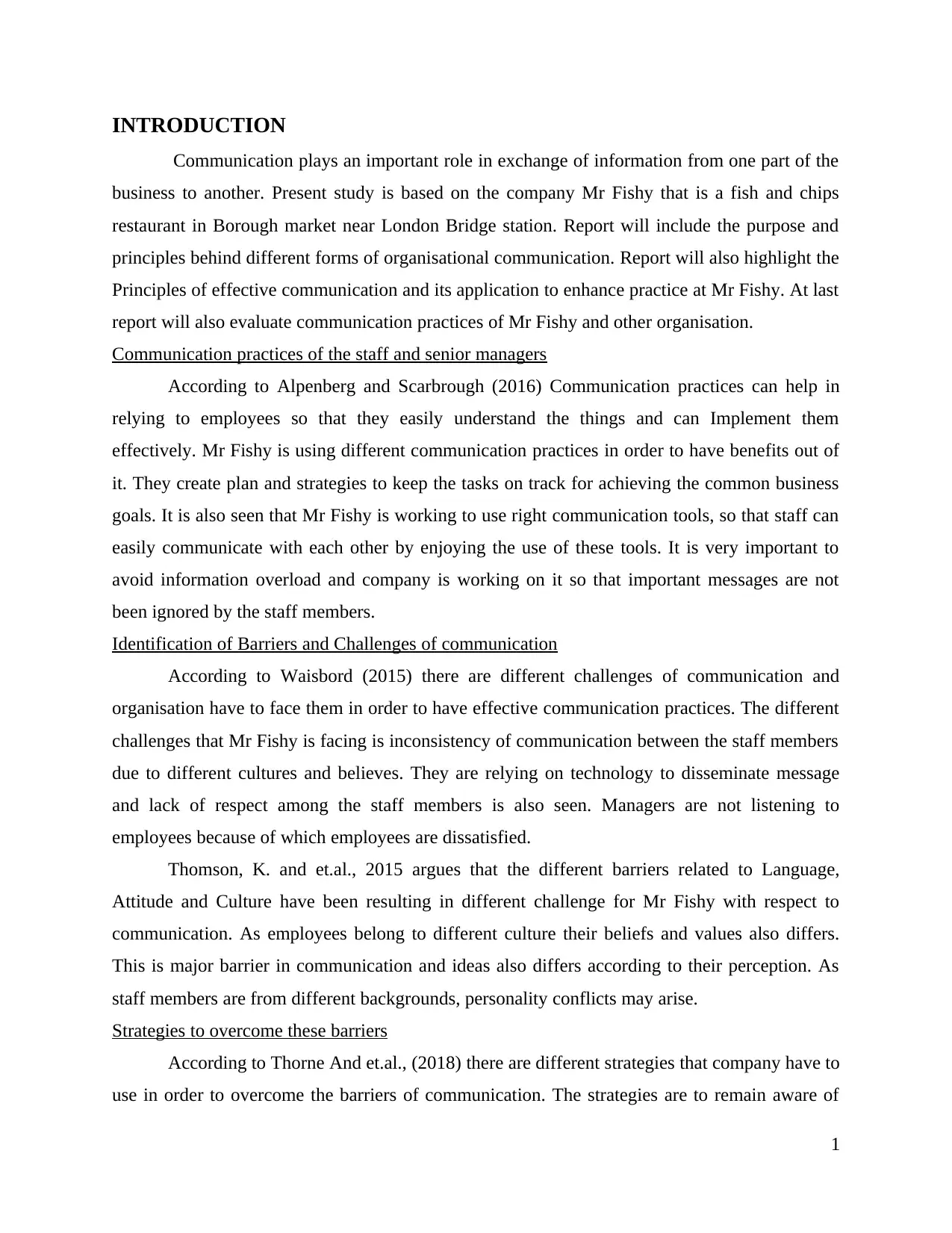
INTRODUCTION
Communication plays an important role in exchange of information from one part of the
business to another. Present study is based on the company Mr Fishy that is a fish and chips
restaurant in Borough market near London Bridge station. Report will include the purpose and
principles behind different forms of organisational communication. Report will also highlight the
Principles of effective communication and its application to enhance practice at Mr Fishy. At last
report will also evaluate communication practices of Mr Fishy and other organisation.
Communication practices of the staff and senior managers
According to Alpenberg and Scarbrough (2016) Communication practices can help in
relying to employees so that they easily understand the things and can Implement them
effectively. Mr Fishy is using different communication practices in order to have benefits out of
it. They create plan and strategies to keep the tasks on track for achieving the common business
goals. It is also seen that Mr Fishy is working to use right communication tools, so that staff can
easily communicate with each other by enjoying the use of these tools. It is very important to
avoid information overload and company is working on it so that important messages are not
been ignored by the staff members.
Identification of Barriers and Challenges of communication
According to Waisbord (2015) there are different challenges of communication and
organisation have to face them in order to have effective communication practices. The different
challenges that Mr Fishy is facing is inconsistency of communication between the staff members
due to different cultures and believes. They are relying on technology to disseminate message
and lack of respect among the staff members is also seen. Managers are not listening to
employees because of which employees are dissatisfied.
Thomson, K. and et.al., 2015 argues that the different barriers related to Language,
Attitude and Culture have been resulting in different challenge for Mr Fishy with respect to
communication. As employees belong to different culture their beliefs and values also differs.
This is major barrier in communication and ideas also differs according to their perception. As
staff members are from different backgrounds, personality conflicts may arise.
Strategies to overcome these barriers
According to Thorne And et.al., (2018) there are different strategies that company have to
use in order to overcome the barriers of communication. The strategies are to remain aware of
1
Communication plays an important role in exchange of information from one part of the
business to another. Present study is based on the company Mr Fishy that is a fish and chips
restaurant in Borough market near London Bridge station. Report will include the purpose and
principles behind different forms of organisational communication. Report will also highlight the
Principles of effective communication and its application to enhance practice at Mr Fishy. At last
report will also evaluate communication practices of Mr Fishy and other organisation.
Communication practices of the staff and senior managers
According to Alpenberg and Scarbrough (2016) Communication practices can help in
relying to employees so that they easily understand the things and can Implement them
effectively. Mr Fishy is using different communication practices in order to have benefits out of
it. They create plan and strategies to keep the tasks on track for achieving the common business
goals. It is also seen that Mr Fishy is working to use right communication tools, so that staff can
easily communicate with each other by enjoying the use of these tools. It is very important to
avoid information overload and company is working on it so that important messages are not
been ignored by the staff members.
Identification of Barriers and Challenges of communication
According to Waisbord (2015) there are different challenges of communication and
organisation have to face them in order to have effective communication practices. The different
challenges that Mr Fishy is facing is inconsistency of communication between the staff members
due to different cultures and believes. They are relying on technology to disseminate message
and lack of respect among the staff members is also seen. Managers are not listening to
employees because of which employees are dissatisfied.
Thomson, K. and et.al., 2015 argues that the different barriers related to Language,
Attitude and Culture have been resulting in different challenge for Mr Fishy with respect to
communication. As employees belong to different culture their beliefs and values also differs.
This is major barrier in communication and ideas also differs according to their perception. As
staff members are from different backgrounds, personality conflicts may arise.
Strategies to overcome these barriers
According to Thorne And et.al., (2018) there are different strategies that company have to
use in order to overcome the barriers of communication. The strategies are to remain aware of
1
⊘ This is a preview!⊘
Do you want full access?
Subscribe today to unlock all pages.

Trusted by 1+ million students worldwide
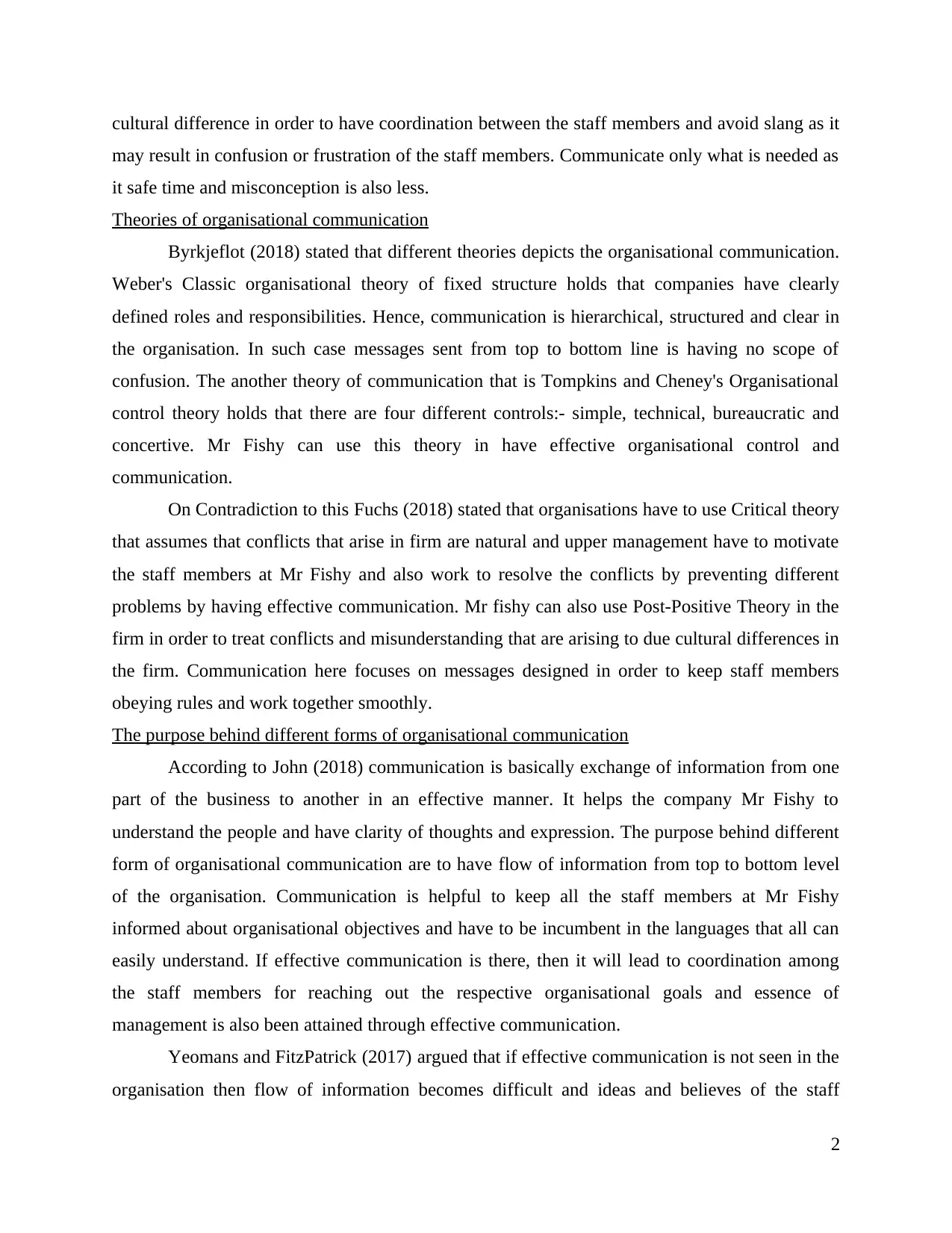
cultural difference in order to have coordination between the staff members and avoid slang as it
may result in confusion or frustration of the staff members. Communicate only what is needed as
it safe time and misconception is also less.
Theories of organisational communication
Byrkjeflot (2018) stated that different theories depicts the organisational communication.
Weber's Classic organisational theory of fixed structure holds that companies have clearly
defined roles and responsibilities. Hence, communication is hierarchical, structured and clear in
the organisation. In such case messages sent from top to bottom line is having no scope of
confusion. The another theory of communication that is Tompkins and Cheney's Organisational
control theory holds that there are four different controls:- simple, technical, bureaucratic and
concertive. Mr Fishy can use this theory in have effective organisational control and
communication.
On Contradiction to this Fuchs (2018) stated that organisations have to use Critical theory
that assumes that conflicts that arise in firm are natural and upper management have to motivate
the staff members at Mr Fishy and also work to resolve the conflicts by preventing different
problems by having effective communication. Mr fishy can also use Post-Positive Theory in the
firm in order to treat conflicts and misunderstanding that are arising to due cultural differences in
the firm. Communication here focuses on messages designed in order to keep staff members
obeying rules and work together smoothly.
The purpose behind different forms of organisational communication
According to John (2018) communication is basically exchange of information from one
part of the business to another in an effective manner. It helps the company Mr Fishy to
understand the people and have clarity of thoughts and expression. The purpose behind different
form of organisational communication are to have flow of information from top to bottom level
of the organisation. Communication is helpful to keep all the staff members at Mr Fishy
informed about organisational objectives and have to be incumbent in the languages that all can
easily understand. If effective communication is there, then it will lead to coordination among
the staff members for reaching out the respective organisational goals and essence of
management is also been attained through effective communication.
Yeomans and FitzPatrick (2017) argued that if effective communication is not seen in the
organisation then flow of information becomes difficult and ideas and believes of the staff
2
may result in confusion or frustration of the staff members. Communicate only what is needed as
it safe time and misconception is also less.
Theories of organisational communication
Byrkjeflot (2018) stated that different theories depicts the organisational communication.
Weber's Classic organisational theory of fixed structure holds that companies have clearly
defined roles and responsibilities. Hence, communication is hierarchical, structured and clear in
the organisation. In such case messages sent from top to bottom line is having no scope of
confusion. The another theory of communication that is Tompkins and Cheney's Organisational
control theory holds that there are four different controls:- simple, technical, bureaucratic and
concertive. Mr Fishy can use this theory in have effective organisational control and
communication.
On Contradiction to this Fuchs (2018) stated that organisations have to use Critical theory
that assumes that conflicts that arise in firm are natural and upper management have to motivate
the staff members at Mr Fishy and also work to resolve the conflicts by preventing different
problems by having effective communication. Mr fishy can also use Post-Positive Theory in the
firm in order to treat conflicts and misunderstanding that are arising to due cultural differences in
the firm. Communication here focuses on messages designed in order to keep staff members
obeying rules and work together smoothly.
The purpose behind different forms of organisational communication
According to John (2018) communication is basically exchange of information from one
part of the business to another in an effective manner. It helps the company Mr Fishy to
understand the people and have clarity of thoughts and expression. The purpose behind different
form of organisational communication are to have flow of information from top to bottom level
of the organisation. Communication is helpful to keep all the staff members at Mr Fishy
informed about organisational objectives and have to be incumbent in the languages that all can
easily understand. If effective communication is there, then it will lead to coordination among
the staff members for reaching out the respective organisational goals and essence of
management is also been attained through effective communication.
Yeomans and FitzPatrick (2017) argued that if effective communication is not seen in the
organisation then flow of information becomes difficult and ideas and believes of the staff
2
Paraphrase This Document
Need a fresh take? Get an instant paraphrase of this document with our AI Paraphraser
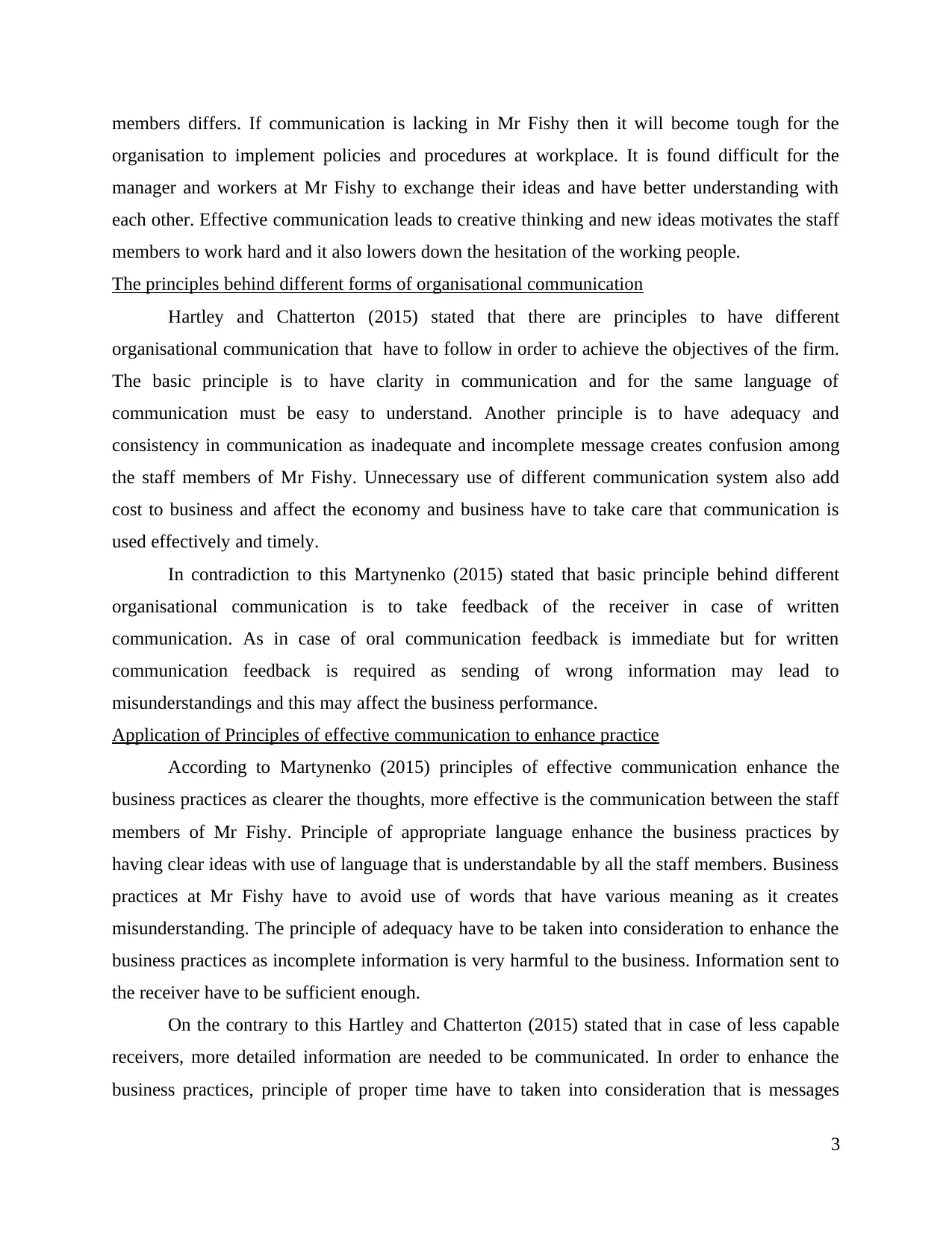
members differs. If communication is lacking in Mr Fishy then it will become tough for the
organisation to implement policies and procedures at workplace. It is found difficult for the
manager and workers at Mr Fishy to exchange their ideas and have better understanding with
each other. Effective communication leads to creative thinking and new ideas motivates the staff
members to work hard and it also lowers down the hesitation of the working people.
The principles behind different forms of organisational communication
Hartley and Chatterton (2015) stated that there are principles to have different
organisational communication that have to follow in order to achieve the objectives of the firm.
The basic principle is to have clarity in communication and for the same language of
communication must be easy to understand. Another principle is to have adequacy and
consistency in communication as inadequate and incomplete message creates confusion among
the staff members of Mr Fishy. Unnecessary use of different communication system also add
cost to business and affect the economy and business have to take care that communication is
used effectively and timely.
In contradiction to this Martynenko (2015) stated that basic principle behind different
organisational communication is to take feedback of the receiver in case of written
communication. As in case of oral communication feedback is immediate but for written
communication feedback is required as sending of wrong information may lead to
misunderstandings and this may affect the business performance.
Application of Principles of effective communication to enhance practice
According to Martynenko (2015) principles of effective communication enhance the
business practices as clearer the thoughts, more effective is the communication between the staff
members of Mr Fishy. Principle of appropriate language enhance the business practices by
having clear ideas with use of language that is understandable by all the staff members. Business
practices at Mr Fishy have to avoid use of words that have various meaning as it creates
misunderstanding. The principle of adequacy have to be taken into consideration to enhance the
business practices as incomplete information is very harmful to the business. Information sent to
the receiver have to be sufficient enough.
On the contrary to this Hartley and Chatterton (2015) stated that in case of less capable
receivers, more detailed information are needed to be communicated. In order to enhance the
business practices, principle of proper time have to taken into consideration that is messages
3
organisation to implement policies and procedures at workplace. It is found difficult for the
manager and workers at Mr Fishy to exchange their ideas and have better understanding with
each other. Effective communication leads to creative thinking and new ideas motivates the staff
members to work hard and it also lowers down the hesitation of the working people.
The principles behind different forms of organisational communication
Hartley and Chatterton (2015) stated that there are principles to have different
organisational communication that have to follow in order to achieve the objectives of the firm.
The basic principle is to have clarity in communication and for the same language of
communication must be easy to understand. Another principle is to have adequacy and
consistency in communication as inadequate and incomplete message creates confusion among
the staff members of Mr Fishy. Unnecessary use of different communication system also add
cost to business and affect the economy and business have to take care that communication is
used effectively and timely.
In contradiction to this Martynenko (2015) stated that basic principle behind different
organisational communication is to take feedback of the receiver in case of written
communication. As in case of oral communication feedback is immediate but for written
communication feedback is required as sending of wrong information may lead to
misunderstandings and this may affect the business performance.
Application of Principles of effective communication to enhance practice
According to Martynenko (2015) principles of effective communication enhance the
business practices as clearer the thoughts, more effective is the communication between the staff
members of Mr Fishy. Principle of appropriate language enhance the business practices by
having clear ideas with use of language that is understandable by all the staff members. Business
practices at Mr Fishy have to avoid use of words that have various meaning as it creates
misunderstanding. The principle of adequacy have to be taken into consideration to enhance the
business practices as incomplete information is very harmful to the business. Information sent to
the receiver have to be sufficient enough.
On the contrary to this Hartley and Chatterton (2015) stated that in case of less capable
receivers, more detailed information are needed to be communicated. In order to enhance the
business practices, principle of proper time have to taken into consideration that is messages
3
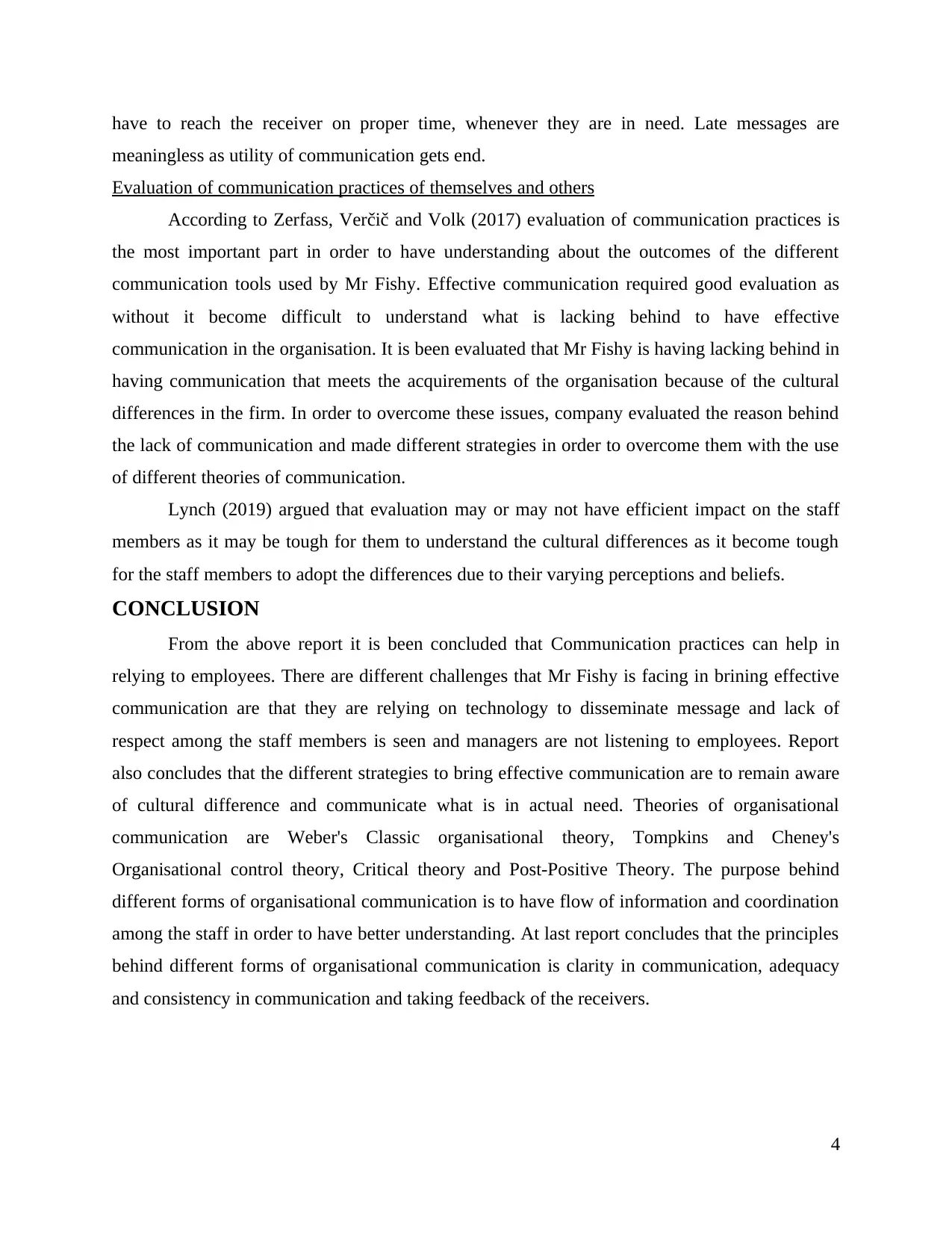
have to reach the receiver on proper time, whenever they are in need. Late messages are
meaningless as utility of communication gets end.
Evaluation of communication practices of themselves and others
According to Zerfass, Verčič and Volk (2017) evaluation of communication practices is
the most important part in order to have understanding about the outcomes of the different
communication tools used by Mr Fishy. Effective communication required good evaluation as
without it become difficult to understand what is lacking behind to have effective
communication in the organisation. It is been evaluated that Mr Fishy is having lacking behind in
having communication that meets the acquirements of the organisation because of the cultural
differences in the firm. In order to overcome these issues, company evaluated the reason behind
the lack of communication and made different strategies in order to overcome them with the use
of different theories of communication.
Lynch (2019) argued that evaluation may or may not have efficient impact on the staff
members as it may be tough for them to understand the cultural differences as it become tough
for the staff members to adopt the differences due to their varying perceptions and beliefs.
CONCLUSION
From the above report it is been concluded that Communication practices can help in
relying to employees. There are different challenges that Mr Fishy is facing in brining effective
communication are that they are relying on technology to disseminate message and lack of
respect among the staff members is seen and managers are not listening to employees. Report
also concludes that the different strategies to bring effective communication are to remain aware
of cultural difference and communicate what is in actual need. Theories of organisational
communication are Weber's Classic organisational theory, Tompkins and Cheney's
Organisational control theory, Critical theory and Post-Positive Theory. The purpose behind
different forms of organisational communication is to have flow of information and coordination
among the staff in order to have better understanding. At last report concludes that the principles
behind different forms of organisational communication is clarity in communication, adequacy
and consistency in communication and taking feedback of the receivers.
4
meaningless as utility of communication gets end.
Evaluation of communication practices of themselves and others
According to Zerfass, Verčič and Volk (2017) evaluation of communication practices is
the most important part in order to have understanding about the outcomes of the different
communication tools used by Mr Fishy. Effective communication required good evaluation as
without it become difficult to understand what is lacking behind to have effective
communication in the organisation. It is been evaluated that Mr Fishy is having lacking behind in
having communication that meets the acquirements of the organisation because of the cultural
differences in the firm. In order to overcome these issues, company evaluated the reason behind
the lack of communication and made different strategies in order to overcome them with the use
of different theories of communication.
Lynch (2019) argued that evaluation may or may not have efficient impact on the staff
members as it may be tough for them to understand the cultural differences as it become tough
for the staff members to adopt the differences due to their varying perceptions and beliefs.
CONCLUSION
From the above report it is been concluded that Communication practices can help in
relying to employees. There are different challenges that Mr Fishy is facing in brining effective
communication are that they are relying on technology to disseminate message and lack of
respect among the staff members is seen and managers are not listening to employees. Report
also concludes that the different strategies to bring effective communication are to remain aware
of cultural difference and communicate what is in actual need. Theories of organisational
communication are Weber's Classic organisational theory, Tompkins and Cheney's
Organisational control theory, Critical theory and Post-Positive Theory. The purpose behind
different forms of organisational communication is to have flow of information and coordination
among the staff in order to have better understanding. At last report concludes that the principles
behind different forms of organisational communication is clarity in communication, adequacy
and consistency in communication and taking feedback of the receivers.
4
⊘ This is a preview!⊘
Do you want full access?
Subscribe today to unlock all pages.

Trusted by 1+ million students worldwide
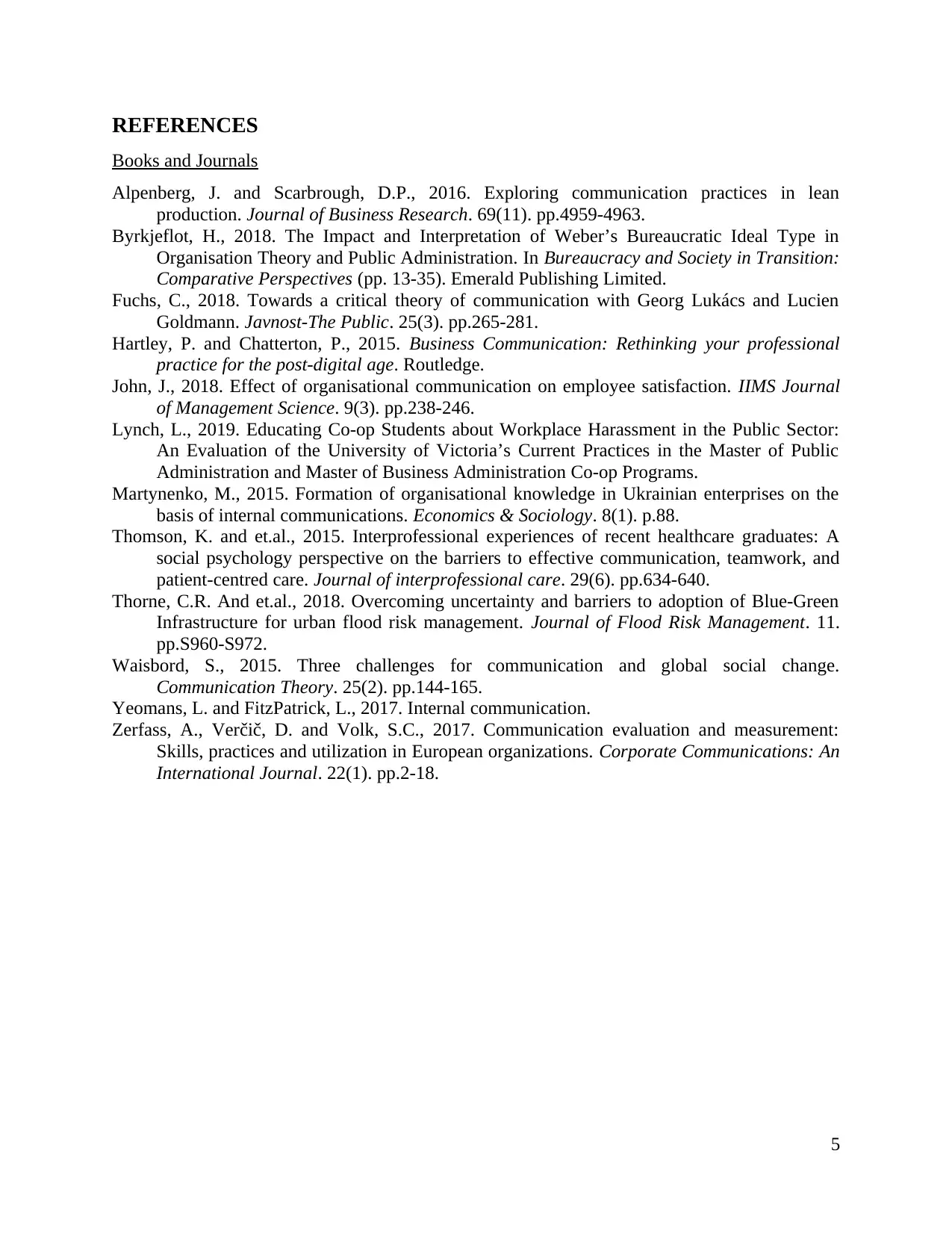
REFERENCES
Books and Journals
Alpenberg, J. and Scarbrough, D.P., 2016. Exploring communication practices in lean
production. Journal of Business Research. 69(11). pp.4959-4963.
Byrkjeflot, H., 2018. The Impact and Interpretation of Weber’s Bureaucratic Ideal Type in
Organisation Theory and Public Administration. In Bureaucracy and Society in Transition:
Comparative Perspectives (pp. 13-35). Emerald Publishing Limited.
Fuchs, C., 2018. Towards a critical theory of communication with Georg Lukács and Lucien
Goldmann. Javnost-The Public. 25(3). pp.265-281.
Hartley, P. and Chatterton, P., 2015. Business Communication: Rethinking your professional
practice for the post-digital age. Routledge.
John, J., 2018. Effect of organisational communication on employee satisfaction. IIMS Journal
of Management Science. 9(3). pp.238-246.
Lynch, L., 2019. Educating Co-op Students about Workplace Harassment in the Public Sector:
An Evaluation of the University of Victoria’s Current Practices in the Master of Public
Administration and Master of Business Administration Co-op Programs.
Martynenko, M., 2015. Formation of organisational knowledge in Ukrainian enterprises on the
basis of internal communications. Economics & Sociology. 8(1). p.88.
Thomson, K. and et.al., 2015. Interprofessional experiences of recent healthcare graduates: A
social psychology perspective on the barriers to effective communication, teamwork, and
patient-centred care. Journal of interprofessional care. 29(6). pp.634-640.
Thorne, C.R. And et.al., 2018. Overcoming uncertainty and barriers to adoption of Blue‐Green
Infrastructure for urban flood risk management. Journal of Flood Risk Management. 11.
pp.S960-S972.
Waisbord, S., 2015. Three challenges for communication and global social change.
Communication Theory. 25(2). pp.144-165.
Yeomans, L. and FitzPatrick, L., 2017. Internal communication.
Zerfass, A., Verčič, D. and Volk, S.C., 2017. Communication evaluation and measurement:
Skills, practices and utilization in European organizations. Corporate Communications: An
International Journal. 22(1). pp.2-18.
5
Books and Journals
Alpenberg, J. and Scarbrough, D.P., 2016. Exploring communication practices in lean
production. Journal of Business Research. 69(11). pp.4959-4963.
Byrkjeflot, H., 2018. The Impact and Interpretation of Weber’s Bureaucratic Ideal Type in
Organisation Theory and Public Administration. In Bureaucracy and Society in Transition:
Comparative Perspectives (pp. 13-35). Emerald Publishing Limited.
Fuchs, C., 2018. Towards a critical theory of communication with Georg Lukács and Lucien
Goldmann. Javnost-The Public. 25(3). pp.265-281.
Hartley, P. and Chatterton, P., 2015. Business Communication: Rethinking your professional
practice for the post-digital age. Routledge.
John, J., 2018. Effect of organisational communication on employee satisfaction. IIMS Journal
of Management Science. 9(3). pp.238-246.
Lynch, L., 2019. Educating Co-op Students about Workplace Harassment in the Public Sector:
An Evaluation of the University of Victoria’s Current Practices in the Master of Public
Administration and Master of Business Administration Co-op Programs.
Martynenko, M., 2015. Formation of organisational knowledge in Ukrainian enterprises on the
basis of internal communications. Economics & Sociology. 8(1). p.88.
Thomson, K. and et.al., 2015. Interprofessional experiences of recent healthcare graduates: A
social psychology perspective on the barriers to effective communication, teamwork, and
patient-centred care. Journal of interprofessional care. 29(6). pp.634-640.
Thorne, C.R. And et.al., 2018. Overcoming uncertainty and barriers to adoption of Blue‐Green
Infrastructure for urban flood risk management. Journal of Flood Risk Management. 11.
pp.S960-S972.
Waisbord, S., 2015. Three challenges for communication and global social change.
Communication Theory. 25(2). pp.144-165.
Yeomans, L. and FitzPatrick, L., 2017. Internal communication.
Zerfass, A., Verčič, D. and Volk, S.C., 2017. Communication evaluation and measurement:
Skills, practices and utilization in European organizations. Corporate Communications: An
International Journal. 22(1). pp.2-18.
5
1 out of 7
Related Documents
Your All-in-One AI-Powered Toolkit for Academic Success.
+13062052269
info@desklib.com
Available 24*7 on WhatsApp / Email
![[object Object]](/_next/static/media/star-bottom.7253800d.svg)
Unlock your academic potential
Copyright © 2020–2025 A2Z Services. All Rights Reserved. Developed and managed by ZUCOL.





